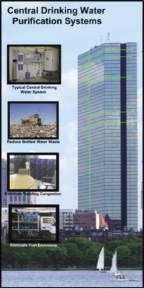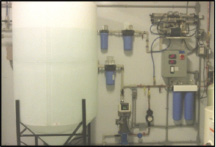The words "water purification and filtration" can refer to a variety of systems, applications and environments. There are residential systems for point-of-use and point-of-entry applications to remove common household water quality issues. In food services, there are filtration systems used to make better tasting water for beverages and ice, and also keep appliances such as steamers running efficiently. Commercially, filters are often used in the work place in conjunction with bottle-less water dispensers to provide employees clean drinking water. There are also systems designed for the biotech, pharmaceutical, medical, and manufacturing industries to provide ultra-pure water needed for their testing, products, labs, etc.
What you might not know is that several businesses and building owners are utilizing the latest water filtration technologies to achieve their corporate sustainability initiatives. This can be achieved by replacing bottled water systems with bottle-less water systems and applying a filtration process that is sized according to the environment and takes into account water quality. Or, this can be a much more elaborate whole building system that requires proper design and engineering by licensed professionals. This type of work is not for amateurs and requires a complete understanding of water filtration and purification technology, and the expertise to prevent any cross-contamination from occurring.
Recently, Atlas designed and installed a central drinking water system to supply approximately 1,500 employees spanning three buildings at the new MathWorks facility in Natick, Mass. MathWorks has been a long-standing customer of Atlas for over 20 years and when they needed work done on their new facility, they knew the company for the job. MathWorks not only wanted to take advantage of the state-of-the-art water technology provided by Atlas that would be used throughout the buildings for drinking water, but also wanted a system that was going to align with their corporate sustainability initiatives.
At the heart of our system is a technology called reverse osmosis, often referred to as RO. RO is a purification technology that removes both organic and inorganic impurities from water using ultra thin membranes. The water enters the membrane and is separated into two different streams.
One stream is the purified water (permeate) and the other stream is the run-off containing the removed impurities (concentrate). The amount of concentrate or waste water generated from a small RO system (home use) is insignificant and not practical to collect and reuse. When designing larger RO systems, reusing the concentrate water is always a consideration. At MathWorks we collect the RO concentrate in a tank, inject a blue dye (indicating non-potable water) and pump it to all of the toilets and urinals in the building, essentially creating a zero discharge RO unit.
In 2007, Atlas embarked on a project that would provide Boston's 62 floor, 1.7 million s/f Hancock Tower with a zero-waste water filtration system. The system is designed to handle a capacity of 4,000 gallons per day and runs to all tenant offices, supplying them with the ability to connect to a centrally located, purified drinking water source. The concentrate water produced from the RO system is used for the building's cooling system, producing a zero-waste system.
These are just a couple of examples of how local businesses and building owners are thinking outside the box to achieve greater efficiency in their buildings and workspaces, thereby attracting tenants who will appreciate the commitment to achieving a greener building environment and will benefit from the latest in water filtration technology.
Michael Nosek is the senior director of sales at Atlas Wastersystems and is a monthly contributing Water Purification author for the New England Real Estate Journal's Green Building section.









